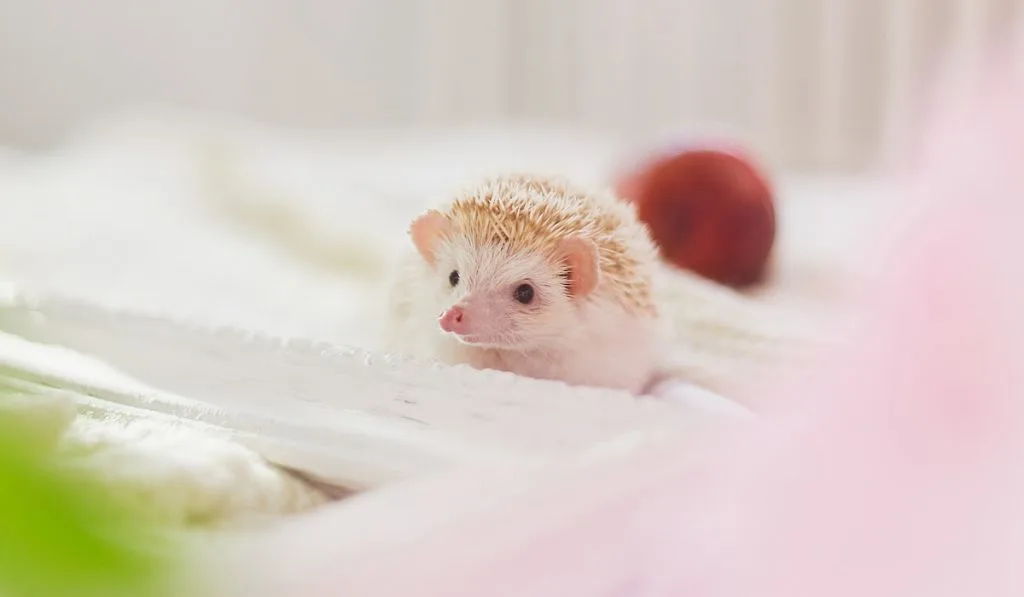Hedgehogs are spiny animals who can be domesticated. But one must keep in mind that it is vital to take good care of them.
Hedgehogs require persistent warmth and heat to keep themselves hearty. But an excess of everything can turn out to be harmful.
So in this article, we will try to find out if the hedgehogs need a heat lamp to survive. This article can certainly help you to take good care of your loving hedgehogs.
Hedgehogs must have a heat lamp or heat pad in their cage. If hedgehogs don’t get ample heat or warmth, they can sometimes go into hibernation. While this is a natural adaptation, it can be fatal in captive hedgehogs.

Make sure that you use a heating lamp like CHE (Ceramic Heat Emitter) which produces only heat and not light. Hedgehogs are nocturnal. If there is light, the hedgehogs get confused and refuse to come out to eat their meals.
CHE is the best source of heat if one is considering keeping a pygmy hedgehog as the amount of heat produced is sufficient enough to keep their sleeping area warm. Instead of heat lamps, we can also try to use heating pads in the place where they sleep.
Precautions When Choosing a Heat Source for Your Hedgehog
It is very important that you choose the right heating element depending on your cage type. Cages with plastic bottoms, for example, can’t be in contact with any heating elements or they will melt, an overhead heat source is best for these.
Likewise, if you have cats or small children that may knock over or try to touch an overhead heating element, choosing a heat pad may be a safer option.
Always consider both the material of the cage as well as the surrounding environment when choosing your heat source.
Heat Lamps for Hedgehogs
I like using this setup which consists of a lamp stand, light fixture and ceramic heat emitter. The stand is great because you can adjust the height.
I typically will use just one side with the heat bulb and the other side with a plain light bulb on a timer to simulate a natural day/night cycle.
Heating Pads for Hedgehogs
Heating pads are another way to provide your hedgehog with a source of warmth. Typically, these come in the form of adhesive heating elements that adhere to the bottom of a glass cage.
The heating element and cord are always placed on the outside but the glass bottom of the cage distributes the heat for the hedgehog.
You’ll want to use a heating pad that covers at least 1/3 to 1/2 of the bottom of the cage.
Clamp Heat Lamps
If your using one of the popular DIY type hedgehog cages with wire panels, a clamp lamp may be a better option for you. This is the one I used when I was raising Dubia and it worked very well for me.
Important features of the heating source
While choosing the heating source, you must keep certain features in your mind. This will help you not to go wrong in any way.
- There should not be an unequal ebb and flow to heat throughout and it should maintain a constant temperature.
- The heating source must not harm the pet and it should not create any burn risks either.
- The heating source should be pocket-friendly and economical for the buyer.
Let us now try to answer certain basic questions that appear in front of you while dealing with hedgehogs.
What Temperatures do Hedgehogs Need
Hedgehogs generally need quite a peculiar environment to survive. The temperature of their cage should not be more than 80 degrees F. They might face overheating issues if the temperature rises more than that.
Typically heat is provided at one side of the cage so that the hedgehog can move under or away from the heat to regulate their own body temperature.
If the temperature falls below 65 degrees, it can lead to the hibernation and possibly death.
Use a Thermometer
Because temperature is such a critical factor in keeping hedgehogs in captivity, it is important that you have at least one (or better, two) thermometers to ensure the hedgehog enclosure is warm enough.
There are various options available including probe thermometers and adhesive ones. I prefer adhesive ones like this one:
Be sure that the thermometer is placed at or near hedgehog height. A thermometer placed at the top of the cage is not going to give you an accurate picture of your hedge hogs environment.
Remember heat rises so you want to make sure the thermometer is placed correctly to get an accurate reading.
Advantages and Disadvantages of Heat Lamps?
One of the cheapest options can be the heat lamps but it is not always the best option to choose. It is important to use a ceramic heat emitter or red heat bulb when using a lamp style heater.
Hedgehogs need the heat source on 24 hours a day. Heat lamp bulbs with a light can affect the day night cycles of this nocturnal animal.
The other disadvantage of the heat lamp is that it can melt plastic when placed too close. If your cage top is plastic coated wire this could be a concern as well.
Of course, the advantages are that it is easy to setup and very cost effective.
Alternatives to Heat Lamps
Several alternatives are sold at the market but it is the owner’s responsibility to have a close inspection while availing any of these alternatives. Let’s go through the alternatives one by one.
- Central heating system– to keep the entire house centrally heated up for a long duration of time, may not be a good idea. And it can also lead to higher electricity bills. But in colder regions where people have smaller apartments, a central heating system can be a good idea. Typically though, this isn’t feasible because most families won’t heat their houses to 80 degrees.
- Heating pads– heating pads can be placed under the cots where your hedgehogs sleep. This would keep them warm for a longer time and save them from hibernating due to a decrease in temperature. But there are certain disadvantages as well. If the heating pad gets too heated up and your pet is unable to move, then it might cause burns and severe damage to your pet. It can increase the internal temperature of the hedgehogs which can be disastrous.
- Heat Rocks– The reptiles can keep themselves warm with the help of these devices. But they are not meant for hedgehogs. The heat rocks can get too hot for them. Therefore, it is best if you don’t consider this alternative for your hedgehog.
- Space heaters– this device requires your attention. While using this you need to keep an eye upon the decrease and increase in temperature. If that is not controlled the hedgehogs can get confused with their cycles. The temperature must be in moderation so that your pet feels comfortable.
- Emergency heating solutions– due to uncertain calamities, one can face a power outbreak. It is during those times that you need some backup or an equally good alternative to keep your hedgehogs warm. That’s when you can use emergency heating solutions. Instant heat packs can be taken into consideration. But it should be check time and again so that it helps your pet during the time of need. You can also provide body heat to your hedgehog. Keep a safe distance and some layers of clothes between you and your pet. It is the most natural way to keep it warm and hearty. Let the hedgehog breath properly by keeping some space in between. It is proved to be an extremely effective formula to help the hedgehogs to keep themselves warm.
Safety matters the most
All the above-mentioned ways of heating are enhanced through electricity. And one must not forget that it is important to keep the safety pointers into consideration.
There is always a danger of overheating, short circuit, fires, etc. it is best to heat only a part of the cage and not the whole.
You can also keep the entire room or your apartment warm so that it is suitable for both you and your hedgehog.
In conclusion, it can easily be drawn that the hedgehogs don’t need head lamps but require some kind of heat or warmth to keep themselves healthy.
The temperature should not be more than 85 F. A continuous variation in temperature can be extremely dangerous for them.
You can adopt various means like heating pads, instant heating machines, that can save your pet during an emergency but if you don’t have anything around you, the last resort is your body heat which is a favourable option for the little spiny creature.
Resources
- Heatley, J. J. (2009). Hedgehogs. In Manual of exotic pet practice (pp. 433-455). WB Saunders.
- Bexton, S. (2016). Hedgehogs. In BSAVA manual of wildlife casualties (pp. 117-136). BSAVA Library.
- https://africanpygmyhedgehogs.com/
- https://hedgehogkeeper.com/do-hedgehogs-need-heat-lamps/
- https://fairhavenhedgehogs.com/heating-info-checklist
